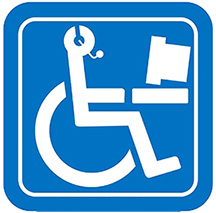The True Meaning of Diversity and Inclusion in the Workplace
January 4, 2016

|
We live in a society that purports to value hiring diverse candidates in the workplace as the right thing to do. Companies garner praise and gain awards left and right for their commitment to inclusive employment. "Inclusion" and "diversity" are buzzwords used liberally in hiring strategies and frequently tossed around in boardrooms and staff meetings. And yet, according the December nTIDE Jobs Report, the rate of unemployment for people with disabilities in the United States continues to rise. While this certainly points to the need for more businesses to adopt hiring policies that focus on inclusion that actually includes people with disabilities, it also raises an important question: are the companies that have already claimed commitment to inclusion trying to look good, or are they truly doing all they can to make full inclusion a priority?
As I searched for jobs a couple years ago, I noticed many businesses go above and beyond the standard equal opportunity employer policy statement on job applications. Several major corporations and organizations have entire pages on their websites dedicated to inviting diverse candidates to apply. This felt encouraging, but also left me wondering whether people with disabilities, like me, are perceived as valuable hires or if the hiring of a person with a disability is obligation fulfillment.
Of course, there is reason to be grateful when chosen for a job, but it is important that people from the disability community who are hired to be seen for their assets, rather than as a token employee with a disability.
Tokenization, though possibly unintentional, can be harmful to both businesses and their employees. I'm happy to say I work in a place where I am respected for who I am. How can employers make it possible that all employees with disabilities are respected for their skills and not for filling a quota, real or imagined. How can job-seekers with disabilities and inclusion-focused employers ensure that tokenization is squelched and the work environment is truly embracing diversity and promoting it as the norm?
Inclusive hiring initiatives have thus far been the crucial start the workforce has needed to bring more of the disability community into the fold. In 2013, the U.S. Department of Labor's Office of Federal Contract Compliance Programs implemented updates to Section 503 of the Rehabilitation Act of 1973 that expand employment opportunities for job-seekers with disabilities by strengthening protections against workplace discrimination. Even with these updated regulations in place, it is time to move beyond the idea of diversity as a strategy or requirement. To many, inclusion in the workplace means doing things such as developing diversity committees, organizing company walks to benefit disability-related charities, or hosting an employee education event on disability. Although these can be useful practices in their own right, such efforts are only the tip of the iceberg. Diversity and inclusion cannot be relegated to a committee that meets every other month or so, or mandatory sensitivity training, or a page in a company handbook. Creating a culture of inclusion necessitates conscious, ongoing actions to correct instances of prejudice and dismantle discrimination.
Incorporating inclusive values throughout a workplace may sound like quite the undertaking, but companies that genuinely prioritize such efforts will reap the benefits in ways far beyond accolades for doing good.
There are some steps to take to get started creating a truly inclusive workforce and work environment. First and foremost, create a workplace that honors openness and disclosure, but not one that pressures colleagues to take on roles as representatives of their minority groups. Second, provide the option for employees to become involved in ways that allow their identities to thrive if they so choose. Third, form mentorship programs that make it possible for employees to strengthen respect, understanding, and connections among colleagues. Most importantly, see "diversity" and "inclusion" not as practices, but as pathways to communities that embrace differences and abilities of all people.
Employers must emphasize not tokenization, but the talent of each employee. More than winning recognition for checking off a series of boxes, a diverse, inclusive workplace is one that truly celebrates employees for who they are and the skills they bring to the workplace.
 Emily Ladau is a writer and disability rights activist whose passion is to harness the powers of language and social media as tools for people to become informed and engaged social justice advocates. She is the owner of Social Justice Media Services, which provides communications, outreach, and social media management services for disability-related organizations. Emily also maintains a blog, Words I Wheel By, as a platform to address discrimination and to encourage people to understand the experience of having a disability in more positive, accepting, and supportive ways. You're welcome to connect with her on Facebook and Twitter.
Emily Ladau is a writer and disability rights activist whose passion is to harness the powers of language and social media as tools for people to become informed and engaged social justice advocates. She is the owner of Social Justice Media Services, which provides communications, outreach, and social media management services for disability-related organizations. Emily also maintains a blog, Words I Wheel By, as a platform to address discrimination and to encourage people to understand the experience of having a disability in more positive, accepting, and supportive ways. You're welcome to connect with her on Facebook and Twitter.







